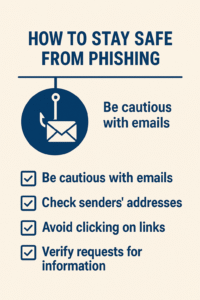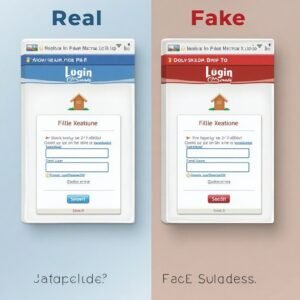What is Phishing and How to Avoid It: A Simple Guide for Everyone
Imagine getting an email from your bank asking you to verify your account. The logo looks real. The language is professional. There’s even a link that takes you to a site that looks just like your bank’s. But here’s the twist — it’s fake.
Welcome to the world of phishing, where cybercriminals disguise themselves as trustworthy sources to steal your personal information. It sounds sneaky — because it is. But don’t worry, by the end of this blog, you’ll know exactly how to spot phishing and how to protect yourself from it.

🐟 What is Phishing?
Phishing is a type of cyberattack where scammers trick you into giving away personal or sensitive information — like passwords, credit card numbers, or bank details. They often pretend to be someone you trust: a bank, a popular online service like Netflix or Amazon, or even your boss.
📧 Most common phishing methods:
-
Email phishing: You get a fake email that looks legit.
-
SMS phishing (Smishing): You receive a text message with a malicious link.
-
Phone phishing (Vishing): You get a call from a “support team” asking for your data.
-
Social media phishing: Hackers send you links or messages on Facebook, Instagram, or LinkedIn.
-
Website phishing: You’re redirected to a fake website that looks real.

🎯 What Do Phishers Want?
They’re usually after:
-
Login credentials (email, banking, work accounts)
-
Credit card and banking info
-
Social Security numbers or ID documents
-
Access to your company’s internal systems
Once they have this data, they can:
-
Steal your money
-
Lock you out of your own accounts
-
Blackmail or impersonate you
-
Launch attacks on your contacts or your company
🧠 How to Spot a Phishing Attempt
Phishing messages often play on emotions — urgency, fear, or curiosity. But they usually have some common signs. Here’s how to spot the red flags:
🔴 1. Urgent or threatening language
“Your account will be suspended in 24 hours” or “Immediate action required.”
✏️ 2. Spelling and grammar mistakes
Legitimate companies rarely send emails full of typos.
📧 3. Strange sender addresses
An email from PayPal coming from paypal123@gmail.com? Big red flag.
🔗 4. Suspicious links
Hover over the link (don’t click it!) and check if the domain looks legit. A real Google link should end in .google.com, not .login-google.secure.net.
📎 5. Unexpected attachments
Never open attachments you weren’t expecting, especially ZIP files or Word documents.

🛡️ How to Avoid Phishing Attacks
Avoiding phishing is like staying street-smart online. Here are some practical steps:
✅ 1. Don’t trust — verify!
Even if an email looks urgent, double-check. Call the sender or open the website directly in your browser. Don’t click links in the email.
🔒 2. Use two-factor authentication (2FA)
Enable 2FA wherever possible. Even if someone gets your password, they won’t get access without the second code.
🔐 3. Use strong, unique passwords
Avoid using the same password for multiple accounts. Use a password manager if you need help remembering them.
🧰 4. Keep your software up to date
Outdated browsers and apps are an easy target for attackers.
📬 5. Check the sender’s email address
A trusted brand will never email you from a public domain like Gmail or Yahoo.
👀 6. Look before you click
Hover over links to see where they really lead. If it looks fishy, it probably is.
🚫 7. Don’t download random attachments
Unless you’re expecting a file, don’t open that attachment. Period.

🧪 Real-Life Examples of Phishing
Let’s walk through a few examples to bring this to life:
🎭 Fake Netflix Email
You receive a message saying: “Your Netflix account is suspended. Click here to update your payment info.” The link takes you to a fake website that looks identical to Netflix’s homepage. But look closer — the URL is netfliix-update.com.
🏦 Bank Alert SMS
A message says: “Your bank account is compromised. Click here to secure it.” The link leads to a fake bank login page designed to steal your credentials.
💼 HR Email at Work
You get an email from someone pretending to be your HR team, asking you to download and sign an updated policy. The attachment contains malware that infects your system.

🏢 What Can Organizations Do?
Phishing doesn’t just target individuals. Companies are prime targets, especially when employees aren’t trained to spot scams.
Here’s what organizations should implement:
-
Cybersecurity awareness training for all employees.
-
Email filtering solutions to block known phishing domains.
-
Simulated phishing tests to test employee responses.
-
Clear reporting process for suspicious emails.
Encouraging a “better safe than sorry” culture can stop many attacks before they succeed.

🤔 What to Do If You’ve Been Phished
Don’t panic — but act fast.
🚨 Steps to take:
-
Change your passwords immediately, especially if you reused them anywhere else.
-
Enable 2FA if you haven’t already.
-
Run a malware scan on your device.
-
Notify your bank if any financial data was shared.
-
Report the phishing to relevant platforms:
-
Gmail: Click “Report Scam”
-
Your IT/security team (if it’s work-related)
-
🧩 Final Thoughts
Scam might seem simple, but it’s one of the most dangerous threats out there because it relies on human error. The good news? You don’t have to be a cybersecurity expert to avoid it.
All it takes is a bit of awareness, a healthy dose of skepticism, and some practical habits. Trust your instincts. If something feels “off,” it probably is.
Stay alert. Stay safe. And always, always think before you click.
✍️ Blog Summary (For Quick Readers)
-
Phishing is a cyberattack where scammers pretend to be trusted sources.
-
They use emails, texts, calls, or fake websites to steal personal info.
-
Watch for red flags: urgent messages, strange links, bad grammar.
-
Use 2FA, strong passwords, and email filters to protect yourself.
-
Always verify suspicious messages directly with the company or person.
🔐 Ready to Learn More?
Stay tuned on ucybersecurity.com for more topics like:
- What is Cyber Security?
- Best antivirus tools for 2025
- What to do if you’ve been hacked
- Career paths in cyber security
Pingback: cybersecurity best practices